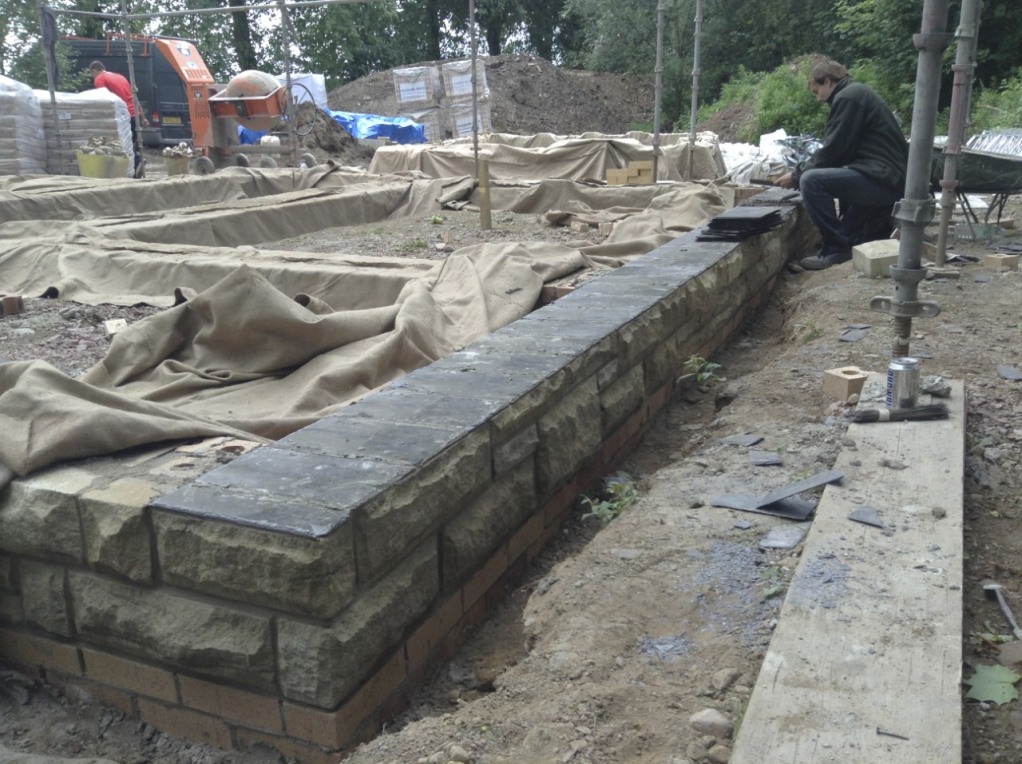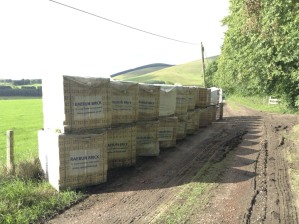We have been very fortunate with the weather this year. Lots of warm weather, dry weather, and even a mild autumn so far. However, there was a week at the end of July when it was very, very, wet. On the 25th, water started collecting around the Peerie Hoose, so S called our groundworks contractor who came and dug a dry well. This was a hole two metres wide on both sides and two metres deep, which was then filled with stones to give the water somewhere to drain. Sorted! Or so we thought…
Tag Archives: plinth walls
Damp protection
To prevent moisture rising from the ground and up into our walls, it was necessary to lay a damp proof course (DPC) after a few layers of brick and stone. These days this is typically accomplished by using a plastic membrane, but as our materials brief stated:
We want to avoid synthetic materials wherever possible. The ideal house would biodegrade over a couple of hundred years of non-use.
We therefore went with one of the traditional methods of damp proofing which is to lay a double layer of slate (the second layer offset from the first and so covering the cracks between slate pieces). The slate we used is second-hand Welsh slate. As you can see in the final image below, after the DPC was laid, further courses of brick and stone were put on top to complete the plinth walls.
More bricks, more stone
Gallery

This gallery contains 9 photos.
We used lime mortar in the plinth walls instead of the now standard-practice of using Portland cement. There were a few of reasons for this. First, part of the design brief was that as many of the materials as possible … Continue reading
Brick & stone
To avoid damp getting into cob walls, it is necessary to build a plinth wall at least 450mm above ground level on the foundations, on top of which the cob walls will be built. ((Technically a plinth wall might not be necessary. Some old cob houses don’t have them, and they are clearly situated in such a way that ground water isn’t an issue and hasn’t ‘melted’ the walls over the years. What we don’t know is how many old cob houses without plinth walks did fall down over the years. It is certainly highly advisable to build a plinth wall to keep the cob from sitting directly on the ground.)) To save money, the bulk of the plinth walls have been built in brick. S looked for second-hand bricks. Most ‘modern’ second-hand brick can’t be reused because it tends to be mortared with Portland cement. The binding strength of Portland cement is stronger than the material of the brick itself, so it’s difficult-to-impossible to clear the mortar off a brick without breaking it. You can find older second-hand bricks, but because it’s labour intensive to clean them off properly (even with older mortars) and tend to be used by people who need to match existing bricks when repairing or extending an existing building, they are expensive.
What S did find is brick seconds from a brick manufacturer in Glasgow. They are cosmetic seconds – bricks that aren’t the right colour or are slightly burned — but structurally sound. Normally they would be broken up for use in aggregate and concrete so as well as using a product that would otherwise be degraded, they are a lot less expensive than ‘normal’ bricks. A win-win!




